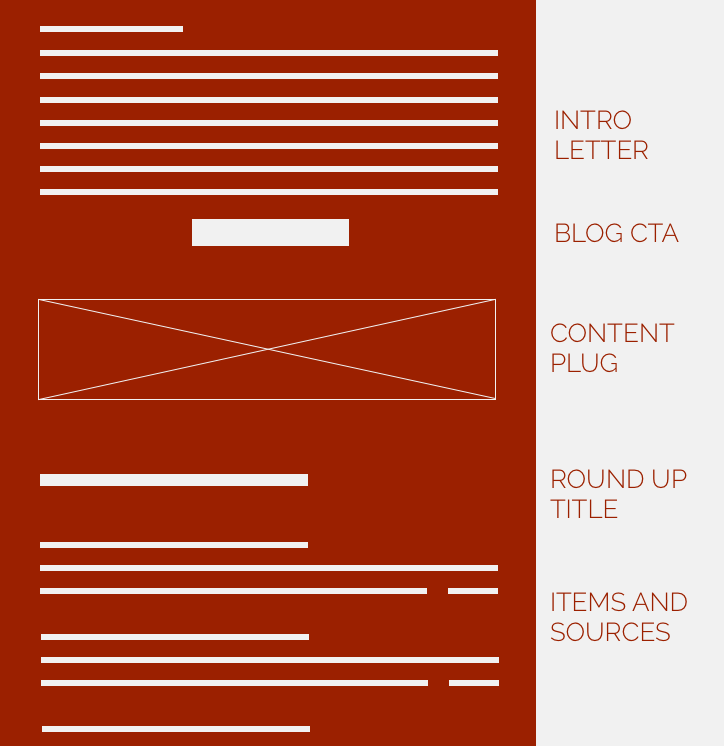Scaling a 10K+ Reader B2B Newsletter in 2 hours a month
tldr
*Newsletters that provide value are damn helpful
- You can automatically curate them by combining Twitter lists, internal Slack channels, and some clever Zapier kung-fu (I walk though this process below)
- My personal favorite newsletter metrics to track are user interactions for prospect segmentation and opens/sends
Facebook turning off the tap for publishers proved why owned direct access is critical. For marketers, that means that emails are damn important. But an email is nothing with a good excuse to ping a user base. Which is why a brilliant newsletter is a gold-mine for:
- Staying top-of-mind during sales cycles
- Getting organic forwards from your readers
- Segmenting prospects based on content engagement (my favorite part)
With those goals in mind, I managed to build a sector-specific B2B newsletter with a super-targeted five-digit distribution list that regularly hits a 30%+ open rate.
The best part? The automated process takes less than two hours of work a month – one day of work a year for 40,000+ impressions from top notch prospects.
Here how I do it.
Step 1: Discover Your Niche.
Start by defining your newsletter’s goal , whether it’s nurturing prospects towards a sales-ready state, brand visibility, or anything else.
Then decide who you’re targeting. More parsimonious audience selection means less time in Promotion Tab land and more time cha-cha’ing to email Shangri La.
Last step? Find what they’re missing in their life. Groove’s Journey to 100K hit entrepreneurs up with updates on building a business. Product Hunt kills it with a daily digest of new products. And the specific type of content you choose will dictate the frequency.
For example, I was going for tech decision makers at logistics companies.
If you think that sounds boring, you’re absolutely right. So I decided to make them feel like the coolest thing since the internal combustion engine by showcasing truly awesome tech developments in their field:
- Audience : Technology decision makers at logistics companies
- Goal : Ongoing awareness with nudges down the sales funnel
- Niche : Showcase logistics technology
- Frequency : Monthly
Time for content curation.
Step 2: Curate the hell out of it. Automatically.
Gartner consultants get paid to report on market trends. Marketers don’t.
To make this cost effective, I needed a way to automatically compile the best updates. The good news is that people inside my company and outside of it were already curating industry news for my newsletter…and they didn’t even know it.
Enter my love affair with Zapier.
Tapping into my company’s fount of knowledge.
Like many companies on Slack, we have two channels where industry news tends to surface: a competition channel ( #competition ) and an industry news channel ( #logtech-updates ). Both are essentially crowdsourced news aggregators compiled by the best in the business – my colleagues. I just needed to make these Slacks easily parsable at the end of the month, when I compile the newsletter.
The Zapier Magic:
- A new Slack message is posted in our #competition or #logtech-updates channels.
- Filter by Zapier ensures that only messages with non-Freightos links continue in the flow.
- Zapier Formatter isolates the URL posted from the Slack channel.
- Store link, message content and date in my newsletter Google Spreadsheet
External Curation
It only took a few months in the sector to identify Twitter movers who regularly share awesome content. I added them into a private Twitter list (the best way to consume Twitter IMO) and use Zapier to easily store them in my Google newsletter spreadsheet.
The Zapier Magic:
- A new Tweet is made in a Twitter list
- Filter by Zapier ensures that a URL exists and that the Tweet is a not a retweet
- Formatter by Zapier isolates the URL tweeted
- A new row is created in Google Sheets with the Tweet URL, the user that tweeted it, likes, retweets, and the description
I should mention that I tried to use Hootsuite to curate the list but scrolling through a month’s worth of tweets is just totally unscalable.
The Media
While 95% of the newsletter content comes from automated sources, I do run a quick monthly site:www.domain.com search, filtered by last month results, on TechCrunch, Verge, Wired, and Mashable with key terms to make sure I’m not missing out on anything big.
This could be automated…but I’m a firm believer in only automating things that will save time and found that there’s still too much guesswork in this process.

XKCD’s take on what to automate
I’m left with a spreadsheet of URLs, descriptions, dates, and Twitter engagement details, based on my Twitter list’s tweets, internal Slack messages, and interesting media reads. All that’s left for me to do is ro cherry-pick the 15-20 items that really pop out from the list of 300, leaving me with:
- A source domain, stripped of path mess (ie techcrunch.com)
- A source URL
- A description
Time to start writing.
Step 3: Editorialize.
At this point, I’ve probably spent about ten minutes curating content for this month’s newsletter. But Mama Buchman didn’t raise no lazy writer…so I open every article I want to share and summarize it in a 20-25 word description, together with an interesting title.
After about twenty minutes, I have the best industry news curated and ready to go. Which means it’s time to editorialize.
I’ve learned that people don’t want just updates – they need an authentic, human voice. Each newsletter kicks off with an observation that’s about 150-200 words . It can be based off of a movie I recently saw, an article I read, or a random Google search…but it needs to plug into the newsletter’s general theme.
Remember, to drive ROI, readers need to eventually head back to your website. So after the lead insight, I push readers to a long-form blog post on our site, followed by the monthly industry roundup we curated above. The lead post usually garners about 12%-15% of clicks, which is just fine with me.
Since the end result is an incredibly informative newsletter (if I do say so myself), I’ll occasionally sprinkle in shout-outs for historical content or free tools we’ve created, positioned as ads between sections of the newsletter. No matter what, every single piece of content should still provide value.

Wireframe of the roundup newsletter
Step 4: Prune and segment based on engagement.
Metrics to ensure awesomeness
Be hard on yourself. If your open rate isn’t there, you’re either building your list with a bait-and-switch or not providing outstanding content. To make sure I’m on track, I track open rates and click-through rates (duh), I also like to track the number of unique email opens. Great, informative emails have a tendency of being forwarded; I like to shoot for an average of two opens per recipient, a good sign that your email is getting forwarded.
Gather insights
By tracking regular reading behavior, you gain superhero level insights into what your users want. If you have VIP users that click through to articles on what specific competitors are up to, that’s priceless information for your sales team. See someone clicking on product updates, also priceless. In my last month email, I saw a VP of R&D at a top logistics company click through on a link about what their competitor was doing with another startup. That’s solid gold where I come from.
Bonsai tree it.
Bonsai trees can regularly be trimmed by up to 10%. So can your email list. Axe people who don’t open emails. I like to send out emails asking unengaged users people if they want to unsubscribe – there’s no reason to have them hanging around the entrance to the party if they’re not going to come in.
Tap into the superstars.
My favorite aspect of forging a relationship with readers is that every once in a while, you build up credit in the permission-marketing bank for an ask. For me, that comes in one of two shapes:
- Contribute content: I love to ask for people to participate in surveys, which we then repurpose into content. Which then brings in more emails. Which creates a god-like content-marketing loop.
- Push the Product: Don’t be afraid, when the time is right, to pop the question. Whether it’s in a PS, a targeted email to segmented, buy-intent users, or a genuinely interesting new product release, you gotta try every once in a while to push people down the funnel.
Enjoy!